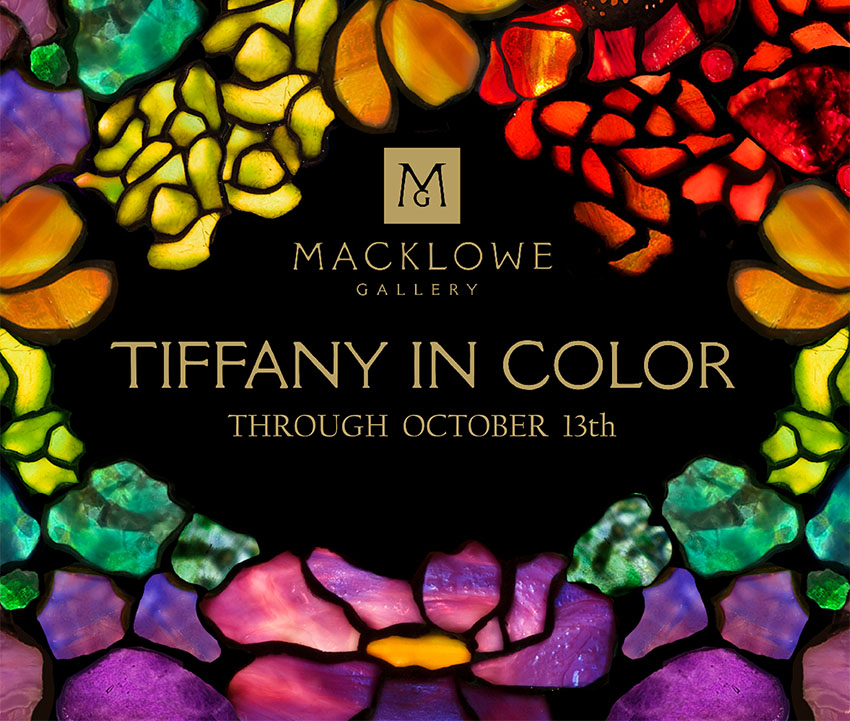
The exhibition displays 20 lamps considered masterpieces
of Louis Comfort Tiffany. Presented with rigorous and detailed
museum information, they are displayed in an exquisite
and original exhibition environment where every detail
has been taken care of. Once again, Ben Macklower proves
that his Gallery is not just a business… it is a passion!
HIGHLIGHTS
View of the space created by Ben Macklowe to display
the works in the exclusive Gold Ruby colour
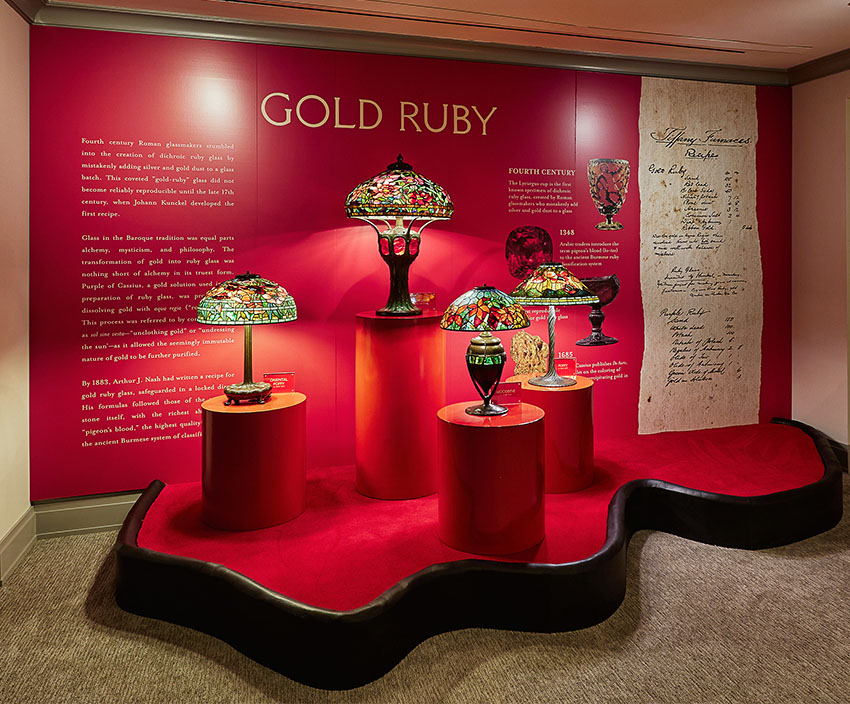
WOODBINE TABLE LAMP
Circa:1900. Dimensions:16″ diameter, 22.25″ height.
Materials: Favrile Glass, Bronze
Curators’ comments: “The shade features mottled glass leaves in shades of amber, ruby red, and yellow-green against a hexagonal aqua and cerulean streaky and confetti glass ground. It sits atop a patinated bronze electrified Turtleback Urn base”.
“An arresting green light glows from within the base, evoking the alluring atmosphere of nineteenth-century Paris”.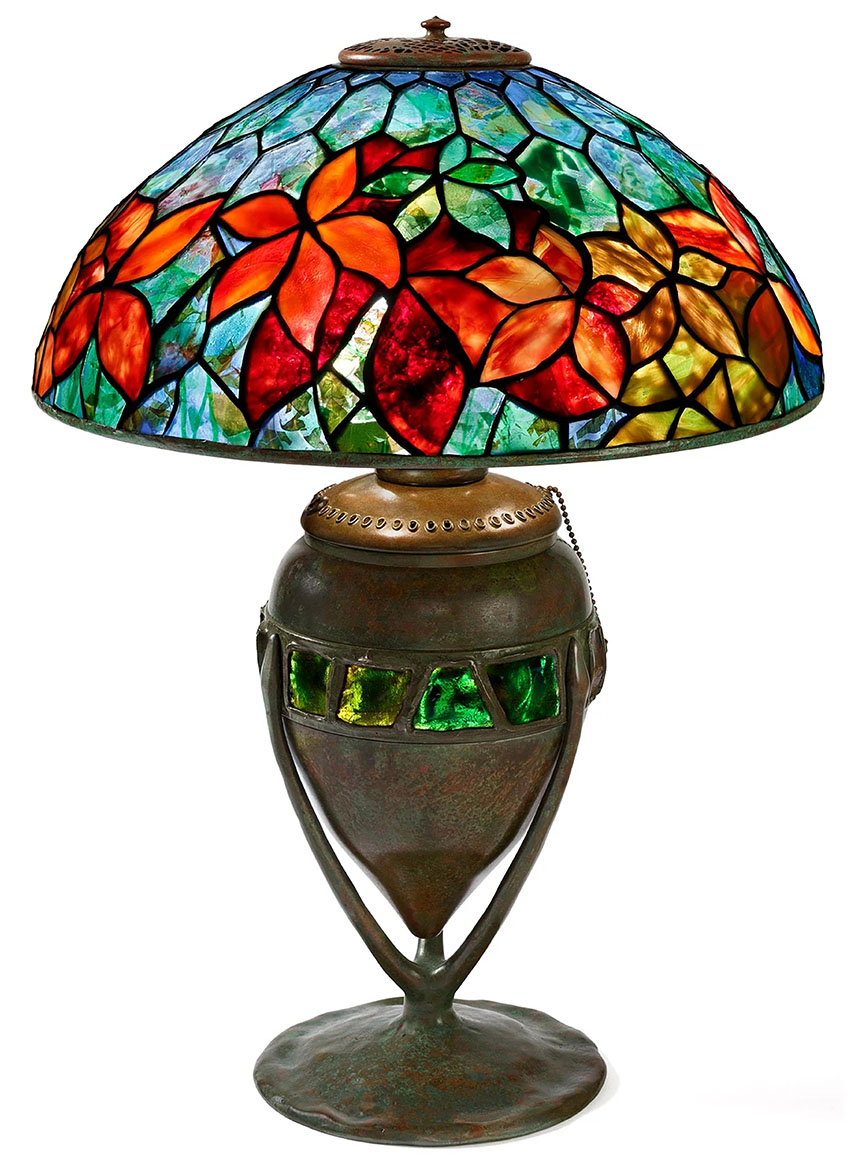
View from the top
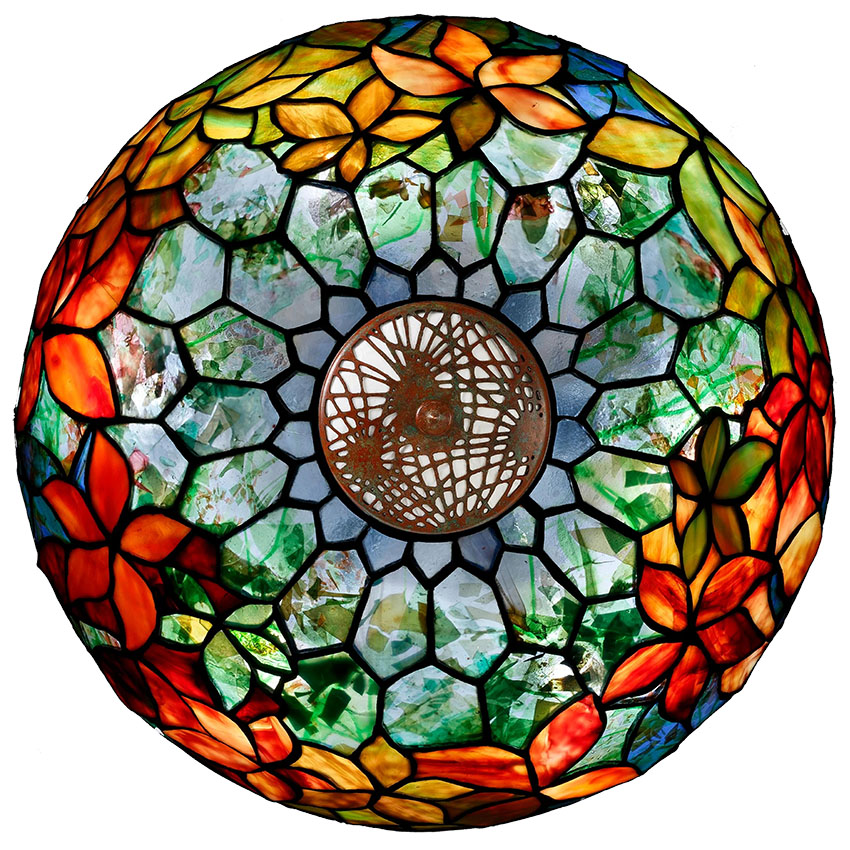
“WIRE MESH POPPY” LAMP
Circa: 1900. Dimensions: 20.25″ diameter (shade), 25″ height (full lamp with base)
Materials: Leaded glass, Bronze
Curators’ comments: “Captured against a smoldering amber and ocher ground of mottled glass, the titular poppies in the shade of this Tiffany Studios New York Poppy lamp dance in harmony with a lower border of stylized leaves”.
“The poppies are depicted in various stages of bloom, some wilting in the final stages of their brilliant lives, others reaching upward in the first stages of unfurling, and others still displaying their magnificent centers, executed in intricate wire mesh”.
“The bottom border provides a lush counter point to the elegantly sparse arrangement of floriforms on the upper portion of the shade, the richly colored and gently striated overlapping leaves adding great depth to the composition. The shade sits on a Twisted Vine base”.
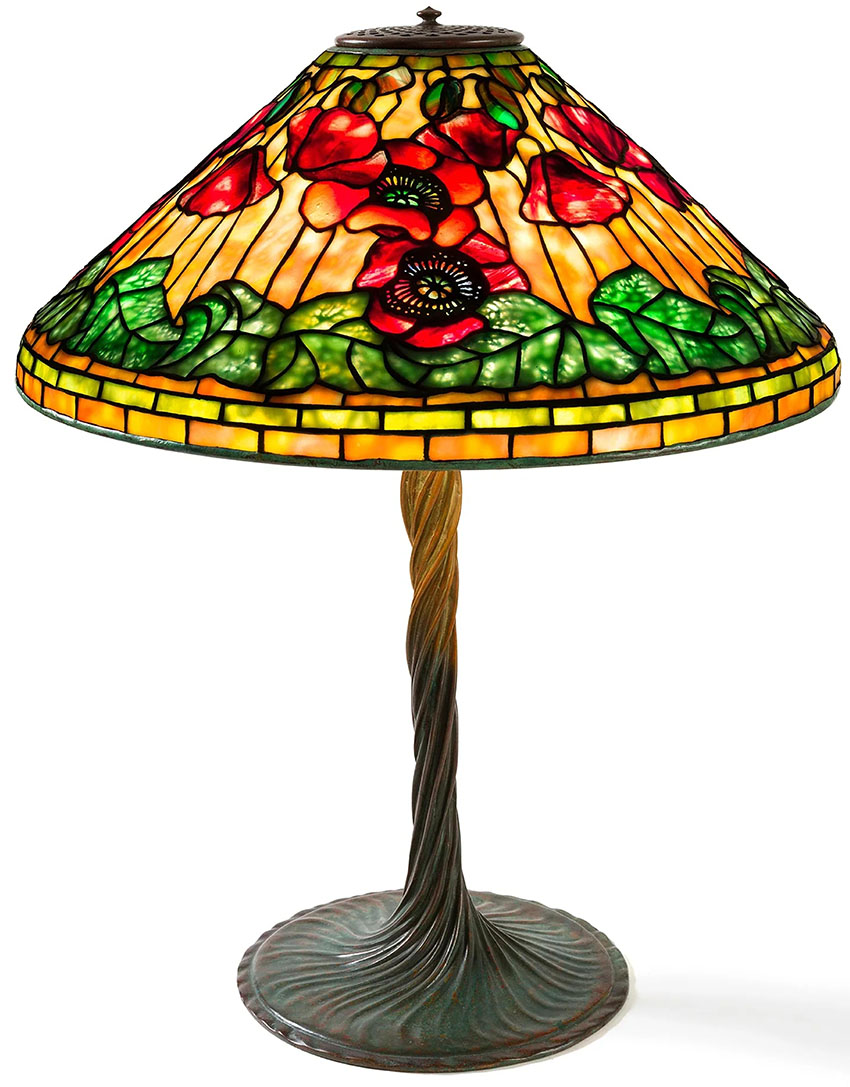
View from the top
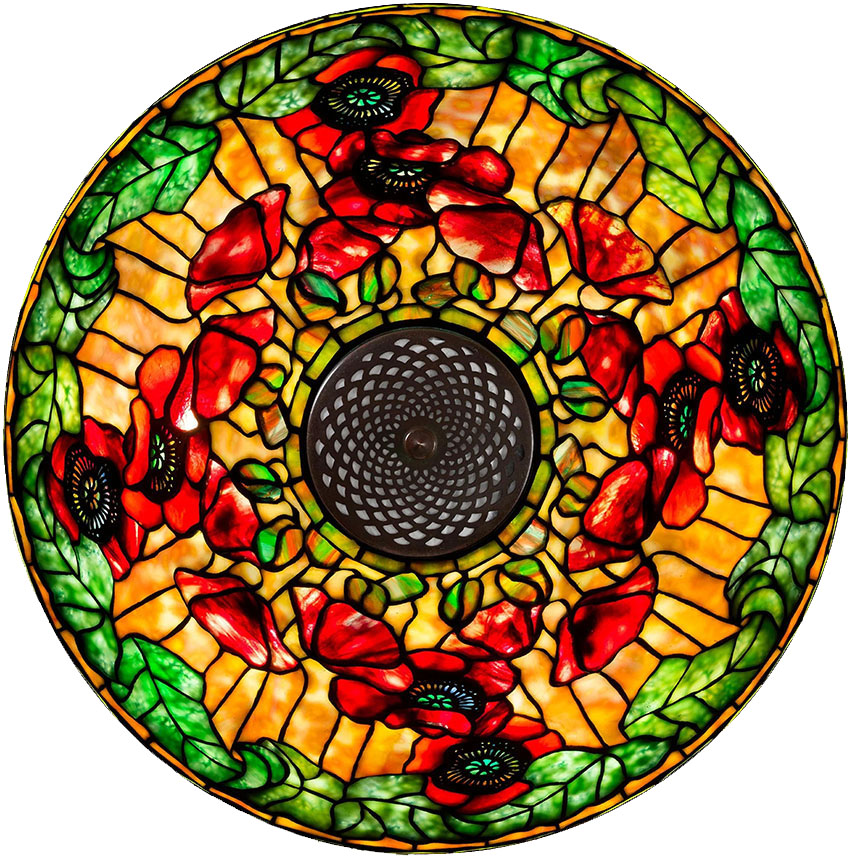
PAIR OF “ORIENTAL POPPY” TABLE LAMPS
Circa: 1910. Size: 18.25″ diameter, 25.5″ height.
Materials: Leaded Glass, Patinated Bronze
Curators’ comments: “This exquisite pair of Tiffany Studios New York Oriental Poppy table lamps, features three narrow bands in kelly green glass can barely contain the vibrant field of bright poppy flowers in this Oriental Poppy lamp by Tiffany Studios New York.”
“Unusually, this composition features not just petal and pistil, but leaves, stems and even soil, creating a full picture of a garden in bloom, captured from an equally unusual angle”.
“The poppy flowers appear larger than life, their petals splayed in every direction and their coloration ranging from ruby red to blush pink, while the shoots and leaves that occupy the lower tiers of the shade are more uniform in shape and color. The shade sits atop a patinated bronze Chased Pod base”.
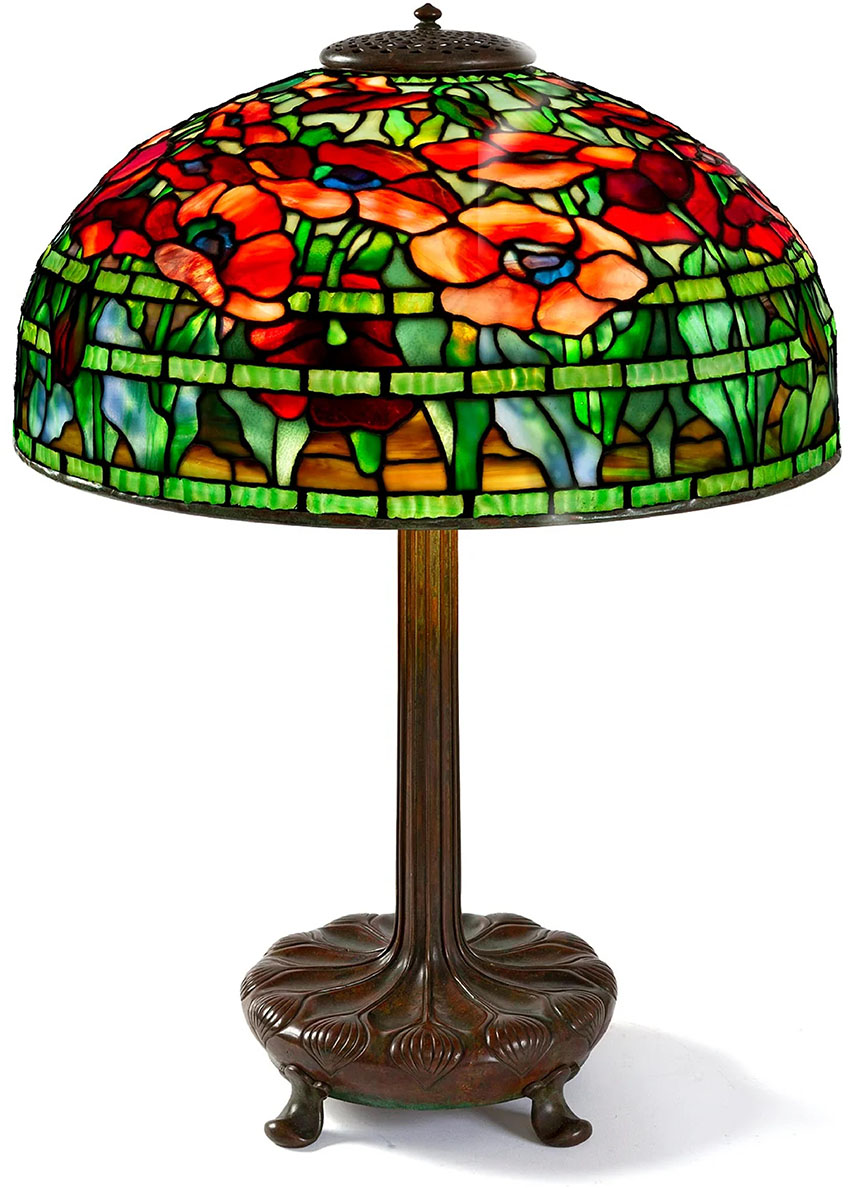
View from the top
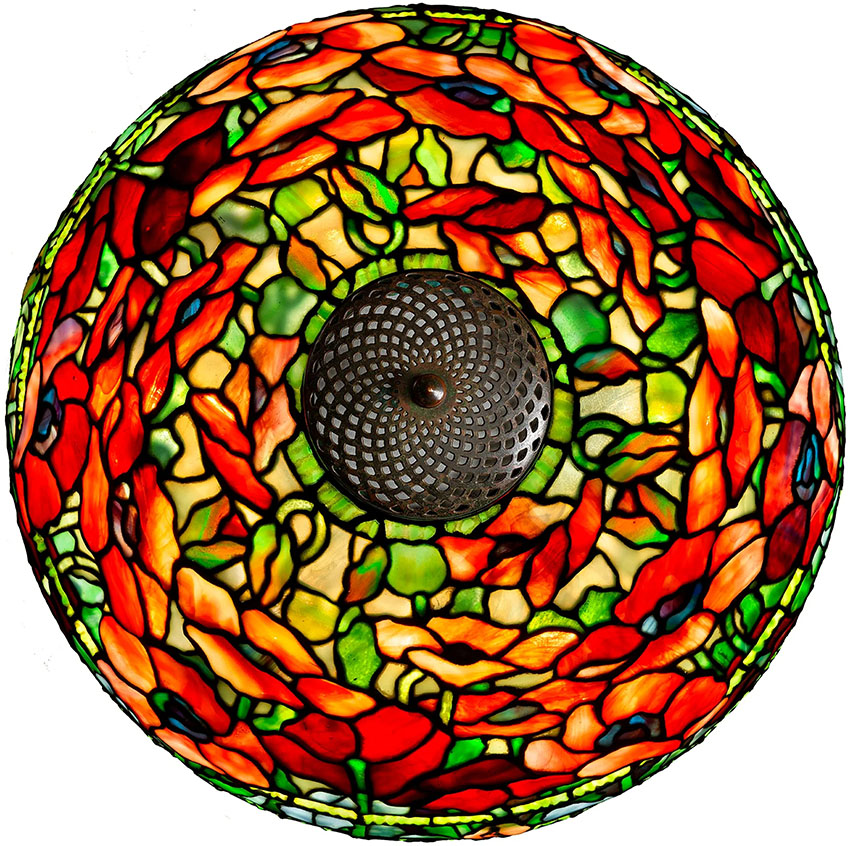
“PEONY” TABLE LAMP
Circa: 1900. Dimensions: 22″ diameter x 32″ height
Materials: Leaded Glass, Patinated Bronze
Curators’ comments: “Tiffany’s Peony table lamp is a work grounded in naturalism, but reaching for the divine. With a shade of resplendent blooms and a mosaic base evoking the hallowed ground of church floors, Tiffany’s peony lamp demonstrates his foundation in both Art Nouveau and ecclesiastical art”.
“To achieve this multi-hued bouquet, Tiffany depicted two different cultivars, a Greek peony, and a Japanese peony. Tiffany used burgundy glass streaked with lapis to express the richness of the Greek Peony—a bloom favored by Neoclassical artists for their symmetry and simplicity. To represent the candy-striped Japanese peony Shima Nishiki, Tiffany used cream glass streaked with fuchsia”.
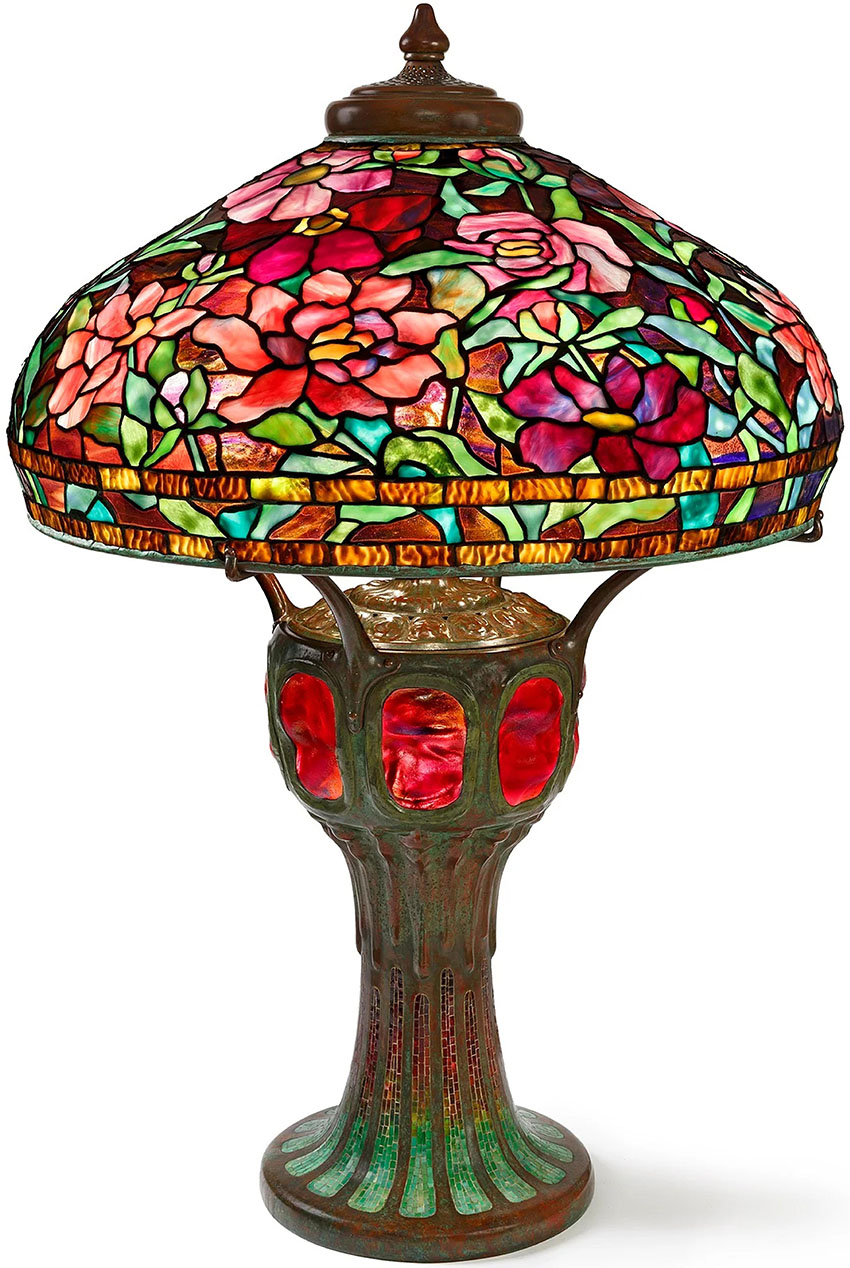
View from the top
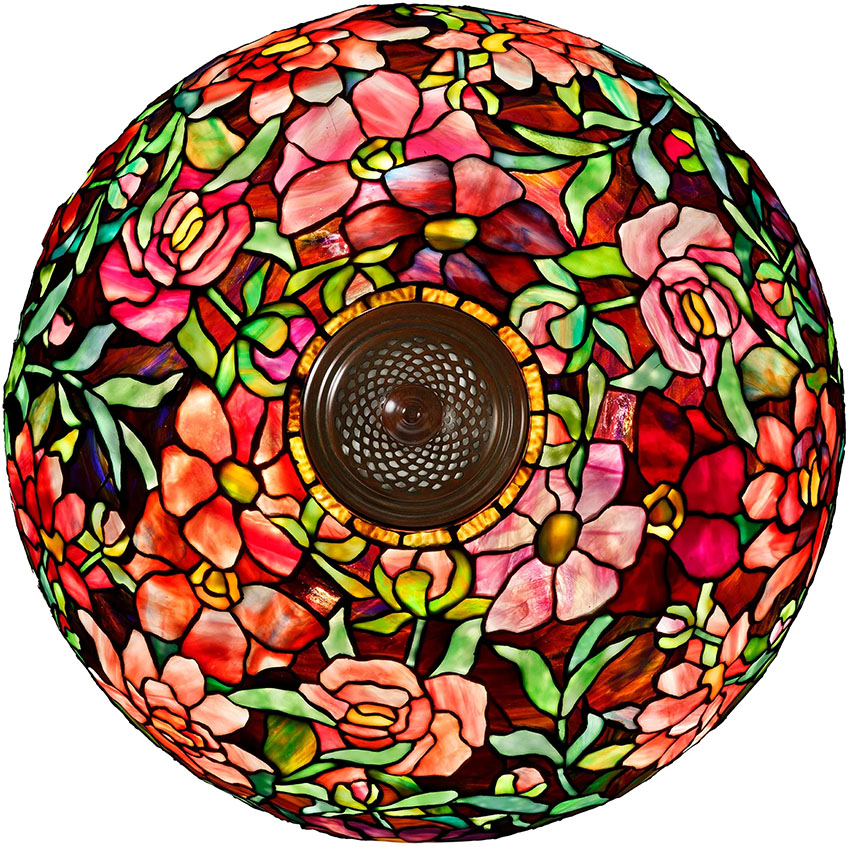
View of the space created by Ben Macklowe to display
the works in the exclusive Lapis Blue colour
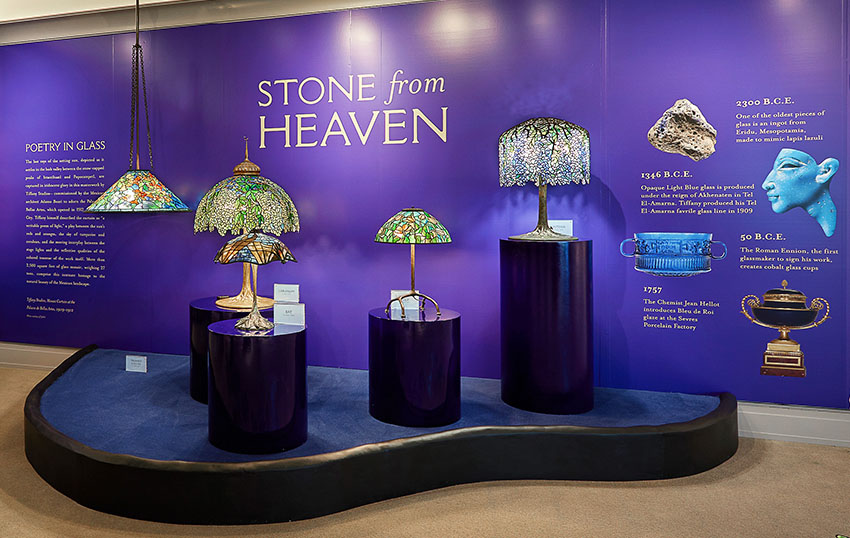
“WISTERIA” TABLE LAMP
Circa: 1902. Dimensions: 18.5″ diameter, 27″ height.
Materials: Leaded glass, Bronze
Curators’ comments: “This remarkable Tiffany Studios New York Wisteria table lamp is a very fine and unusually rare lamp, composed of a palette of wisteria blossoms in shades of blue, green, cream and white that cascade down the shade to an irregular border”.
“The blossoms are surrounded by abundant leaves in varying shades of green and are delicately interspersed with confetti glass, lending them added three-dimensionality. The shade has a latticework top, portraying the branches and stems of a wisteria vine. The base, designed specifically to hold the shade, is also embellished with vegetal, vine-like properties”.
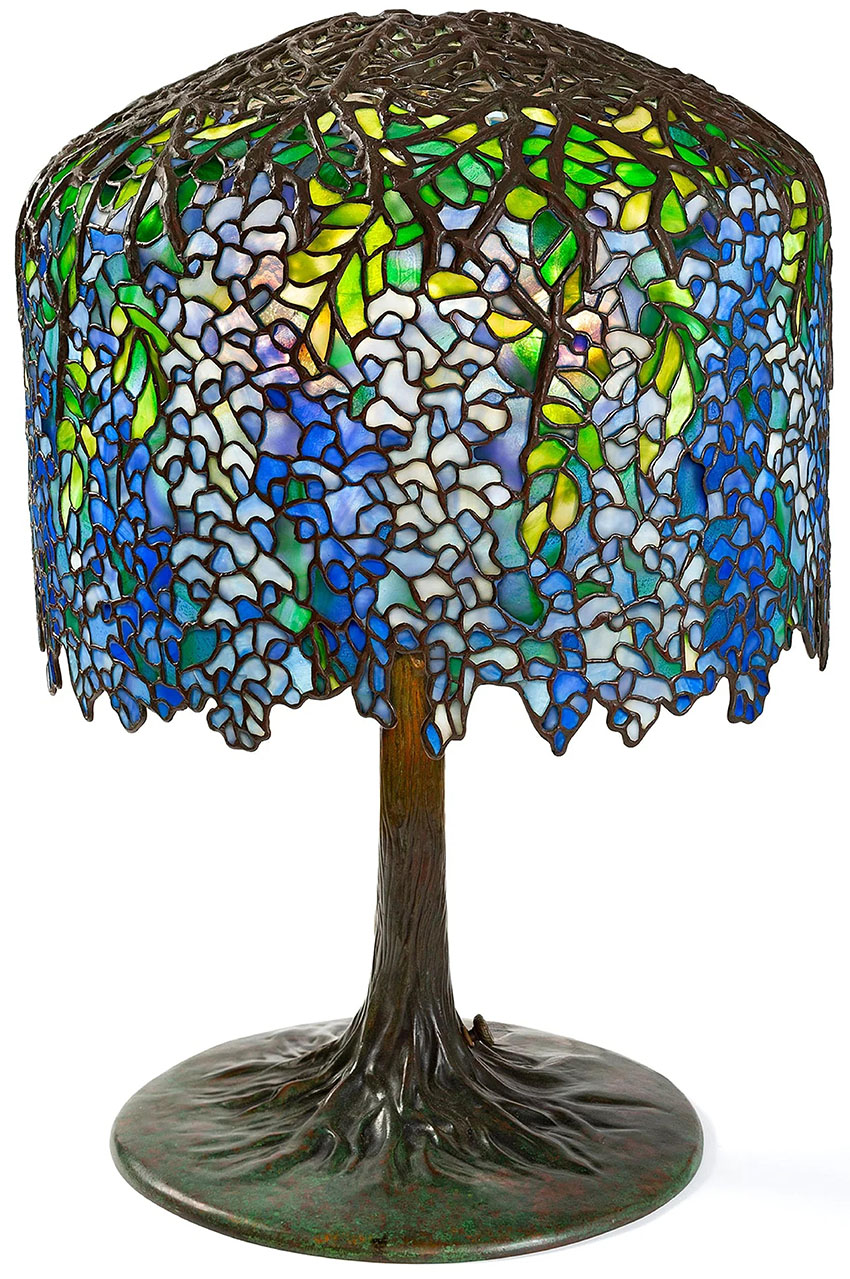
View from the top
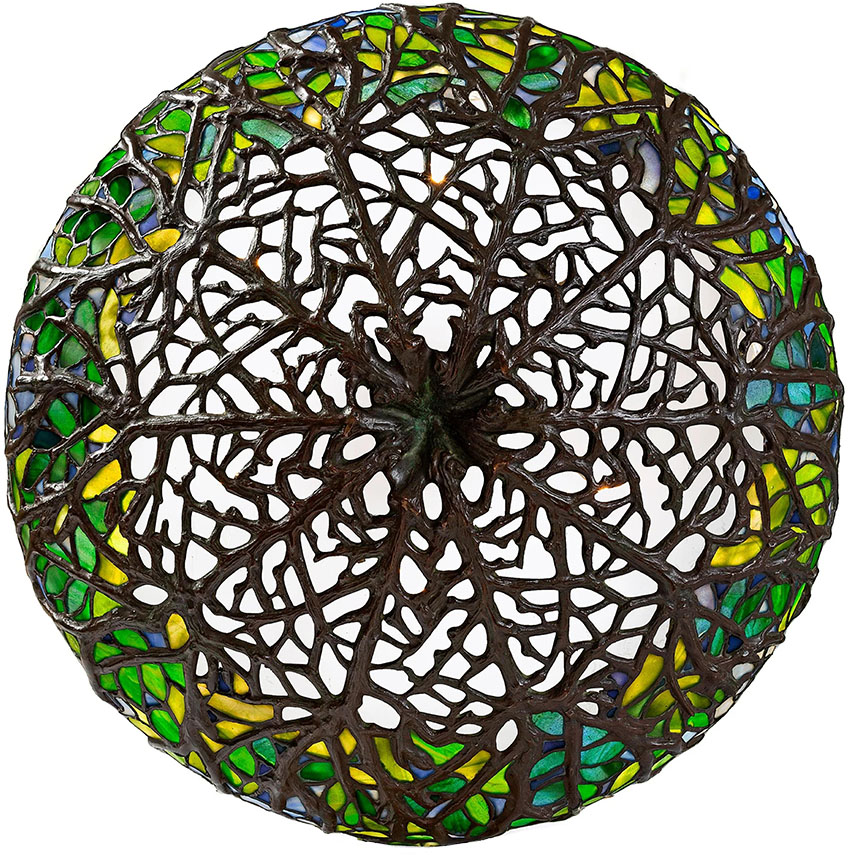
“LABURNUM” CHANDELIER
Circa: 1900’s. Dimensions: 21.5″ diameter, 43″ height (with chain)
Materials: Leaded Glass, Bronze
Curators’ comments: “This Tiffany Studios New York Laburnum chandelier is a much-celebrated piece that features a simple but multihued, multifaceted, and expertly applied color palette that allows each compositional element of the piece to play its own wonderful part”.
“The richly brown tangle of branches that begin at the apex of the shade brings the eye downward through a resolute and deeply hued blue background, accented by variously colored green leaves, before reaching the wonderfully yellow laburnum bloom. Perhaps the most visually interesting aspect of the shade is its unique border, which ripples and undulates, following the outline of the bunches of blooms of the laburnum flower”.
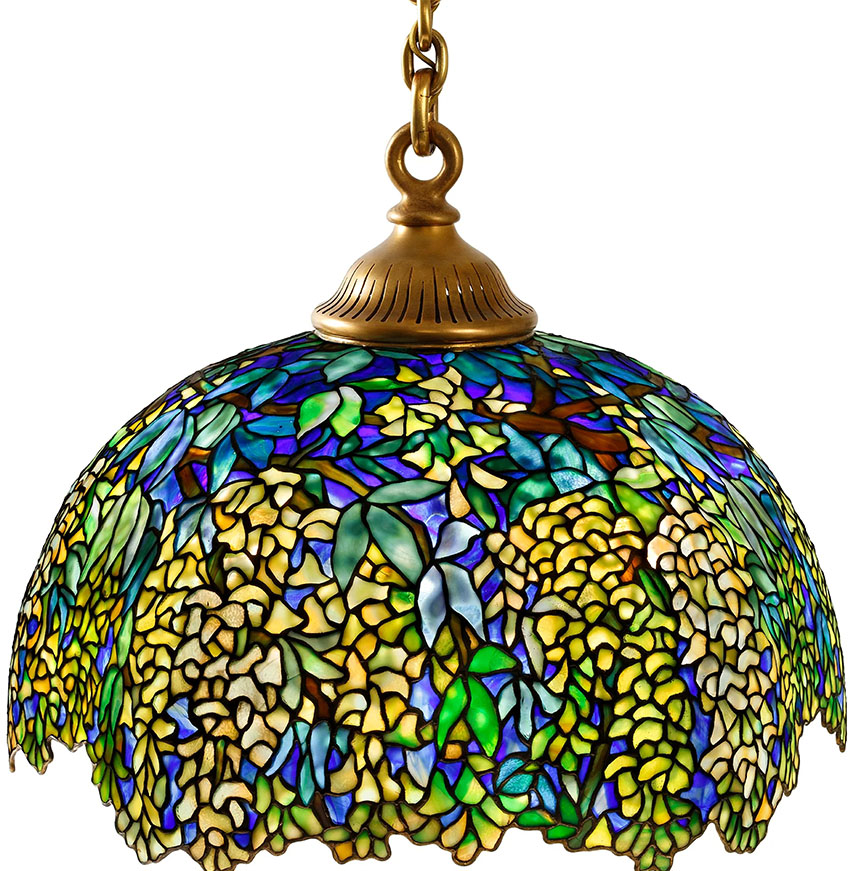
Inside view
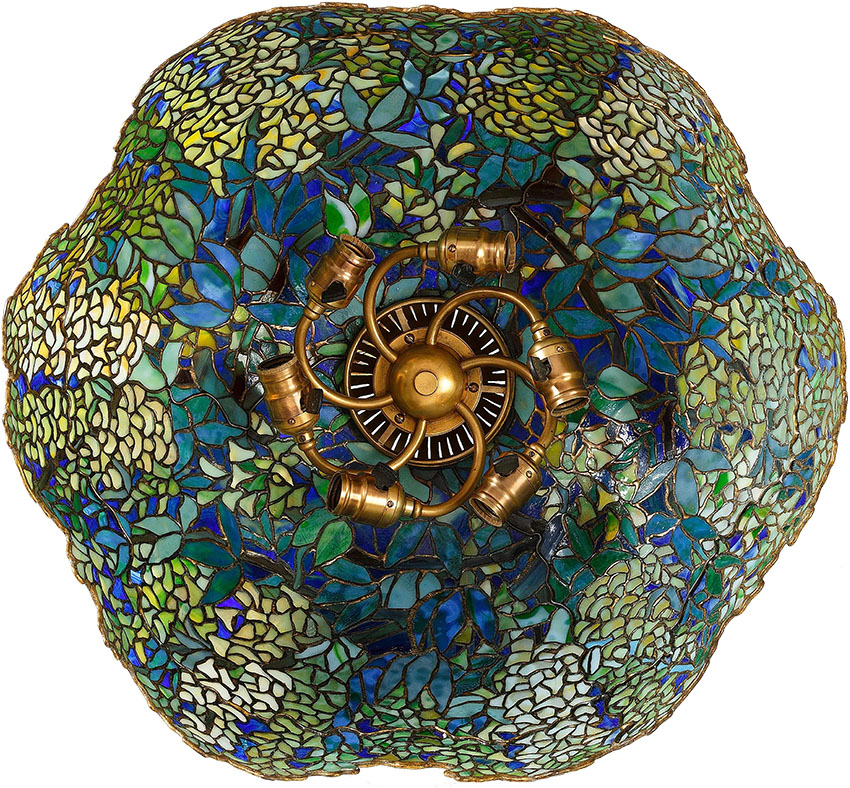
“FLOWERING WATER LILY” TABLE LAMP
Circa: 1905. Dimensions: 26″ height, 20″ diameter
Materials: Favrile glass, Bronze
Curators’ comments: “This Tiffany Studios New York Flowering Water Lily leaded glass and bronze table lamp begins with joyous green pads, which serve as the base to the blooms that take center stage in this wonderful, watery composition are constructed of mottled glass with tints of yellow and orange. Large, white blooms in white-pink are colored so as to appear almost velvety to the touch, while the background, due to being executed in ripple glass, truly captures the appearance of a deep, clear pond”.
“The glass shifts from cerulean blue to smoky black flint. The pink flowers against black background recall the famille-noir ceramics of the Qing dynasty, which were composed of multicolor flowers and leaves against black enamel. A band of green mottled glass, interrupted by an occasional bud, rims the aperture and lower border. Its depth of color, the brilliance of design, and relative rarity combine to make this Flowering Water Lily one of the most impressive of all Tiffany lamp shades, fully entitled to the dash number (indicating a special order) awarded it. The shade sits atop a patinated bronze cat tail base”.
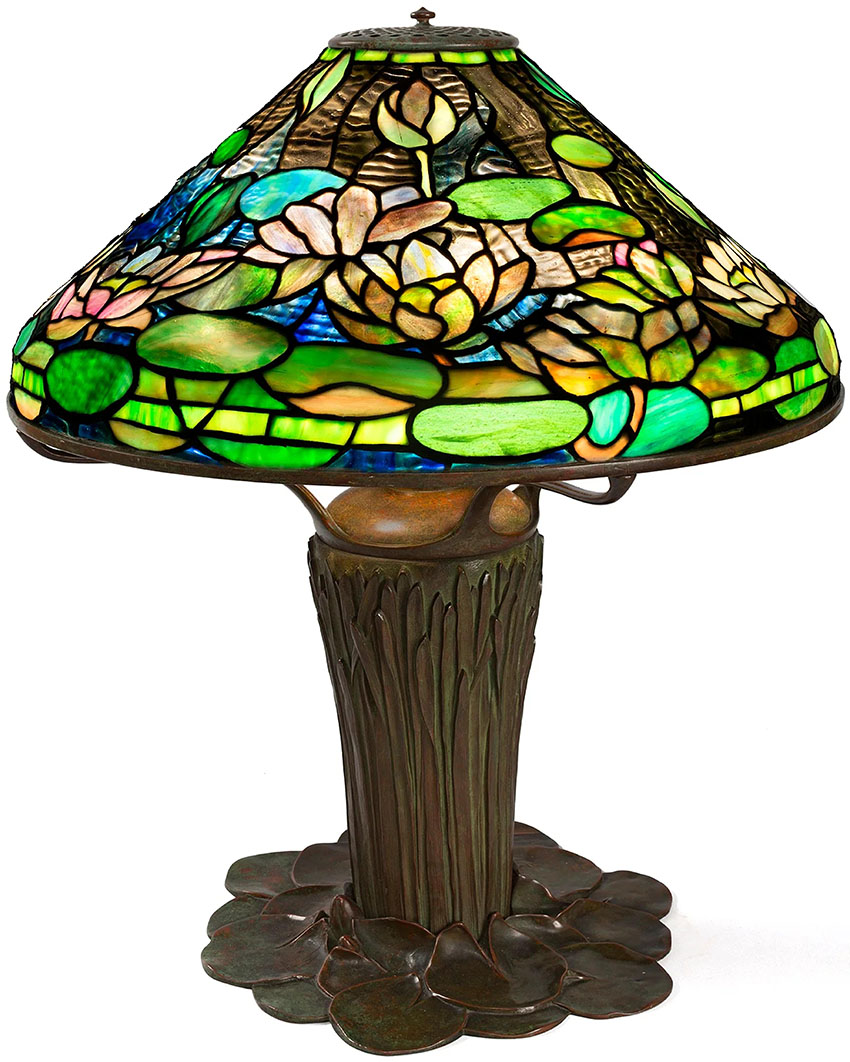
View from the top
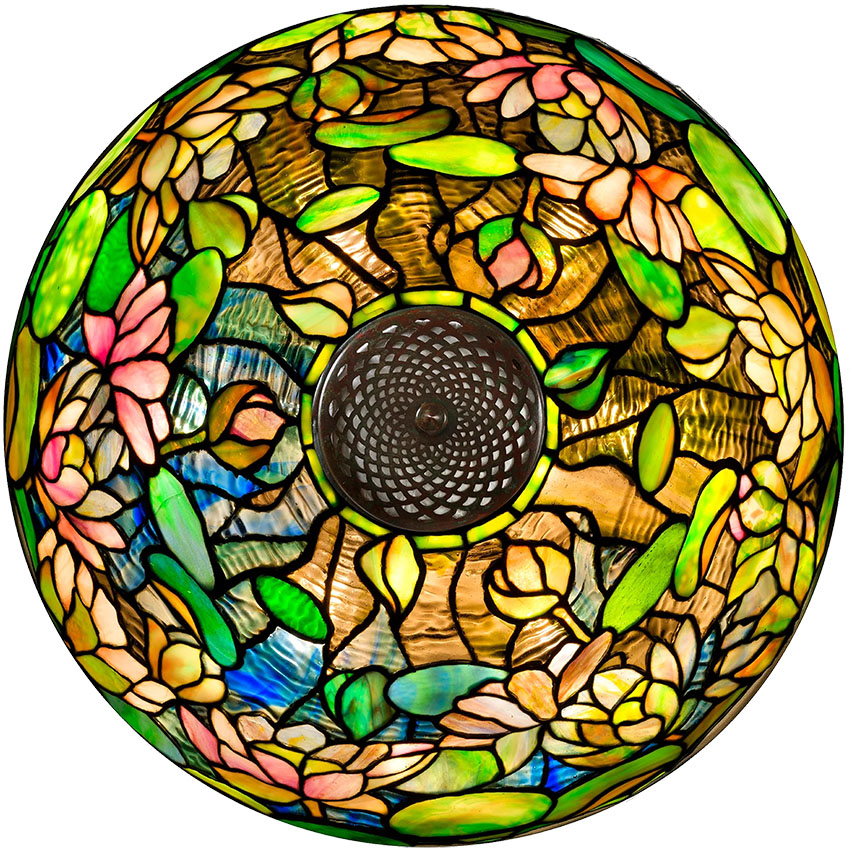
“WINDSWEPT TULIP” TABLE LAMP
Circa: 1900-1910. Size: 16″ diameter, 24″ height
Materials: Leaded Glass, Bronze
Curators’ comments: “This Tiffany Studios lamp with a polychrome Irregular Tulip shade dates from the early 20th century. Composed of a colorful variety of streaked and mottled tiles, a bed of three clusters of vibrant to pale orange tulips, stirred in the wind, surrounds the shade, providing a field mouse viewof blossoms, stalks and leaves in various stages of maturity against an open blue sky streaked with high clouds”.
“The subtly patinated bronze “root” base, while formed by machine, was hand-finished to create a hewn appearance, while the early bronze cap is pierced with a fractal motif. Lamps with tulips as their subject, rendered in dynamic naturalistic settings, formed an important and popular part of Tiffany Studios earliest shade series”.
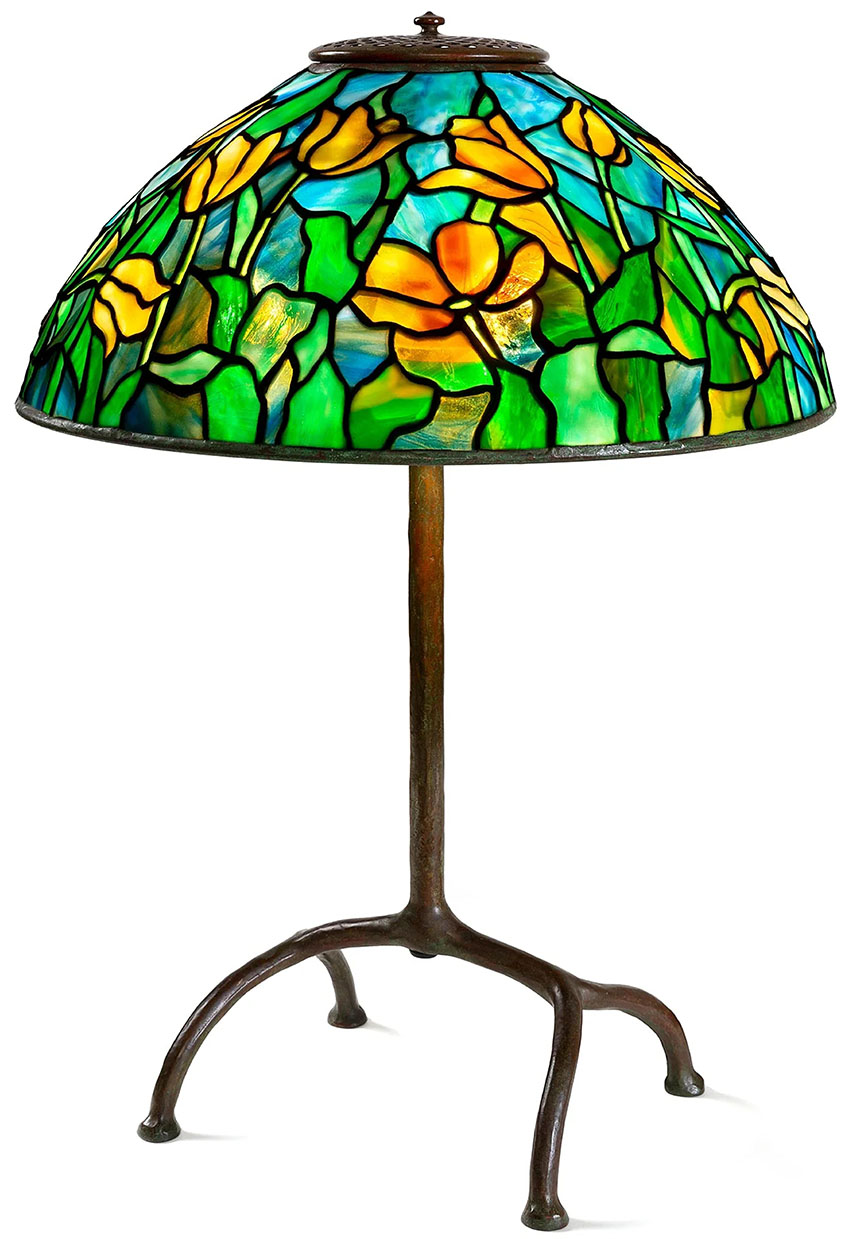
View from the top
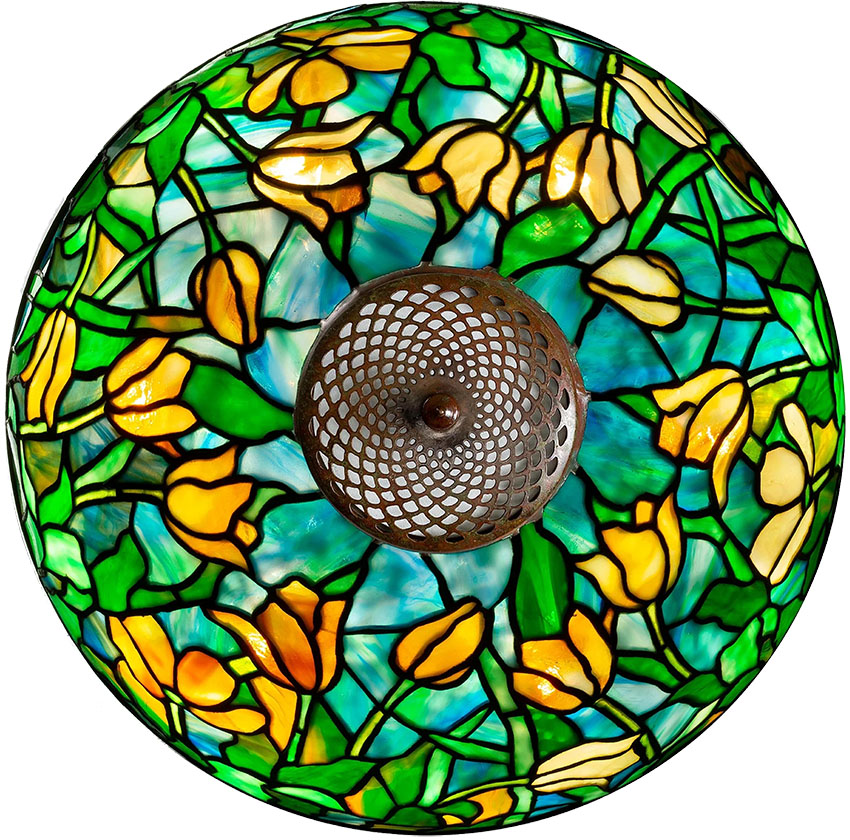
View of the space created by Ben Macklowe to display
the works in the exclusive Imperial Yellow colour

“DROPHEAD DRAGONFLY” FLOOR LAMP
Circa: 1900. Dimensions: 64″ height, 22″ diameter
Materials: Leaded glass, Gilt Bronze
Curators’ comments: “This Tiffany Studios New York glass and bronze Drophead Dragonfly floor lamp features a leaded glass shade depicting turquoise green dragonflies with mottled turquoise, honey and whiskey colored wings, against a graduated turquoise, green, red and amber shade; further adorned with whiskey, honey and ruby colored glass jewels.”
“The shade sits atop a patinated bronze Tree Trunk base”.

Detail of the base
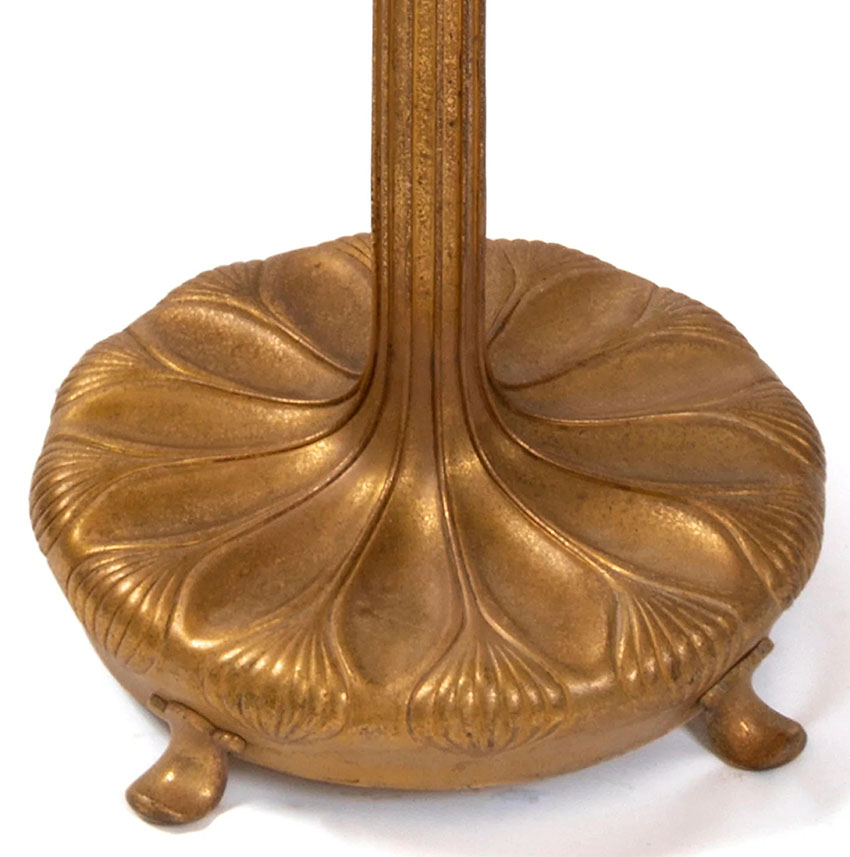
“RUSSIAN” TABLE LAMP
Circa:1900. Dimensions: 20.25″ diameter (shade), 24″ height (full lamp with base)
Materials: Leaded glass, Bronze
Curators’ comments: “A Tiffany Studios New York Russian table lamp in which intricate patterning in bright clementine hues can be found dancing over a background that graduates from sky blue with interruptions of blush to a resolute royal blue at its apex”.
“Large panels of rippling turtleback glass in deep amber mimic the appearance of decorative windows, or perhaps an alcove in relief, and are framed in starkly cut, rectangular panels of glass in similar orange tones”.
“The lamp sits on a a tapering square columnar based, depicting a different woman on each of the four sides above the inscriptions Veritas, Charitas, Fides and Puritas” (Truth, Charity, Loyalty, and Purity.)
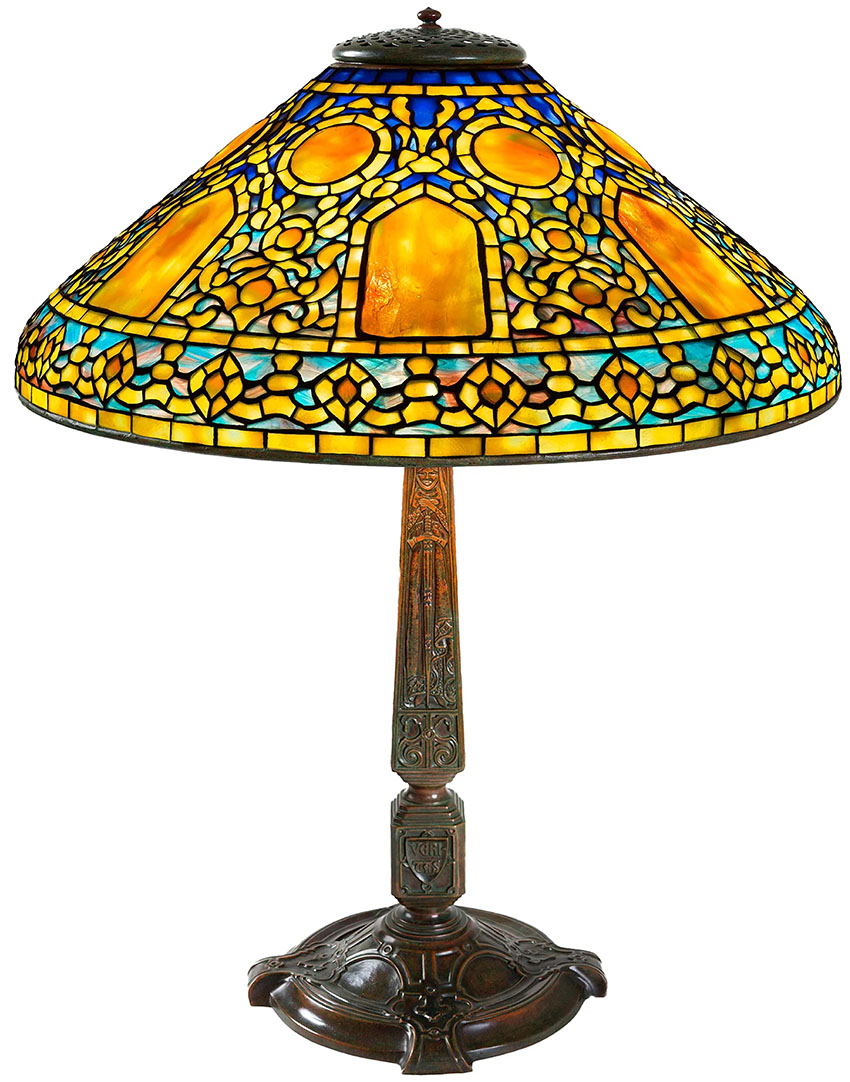
View from the top

“SPIDER” TABLE LAMP
Circa: 1900. Dimensions: 15.75″ diameter, 21″ height
Materials: Glass, Bronze
Curators’ comments: “This Tiffany Studios New York glass and bronze Spider table lamp features a mottled golden glass shade of undulating yellow-green hues, atop a patinated bronze Inverted Mushroom base”.
“With Gothic, arachnid-type raised veins spreading from the clawed top of the lamp, the starkly geometric and roughly monochromatic lamp is far from simplistic, as a broadly scalloped border adds to the sense that elements of this amazing lamp are alive”.
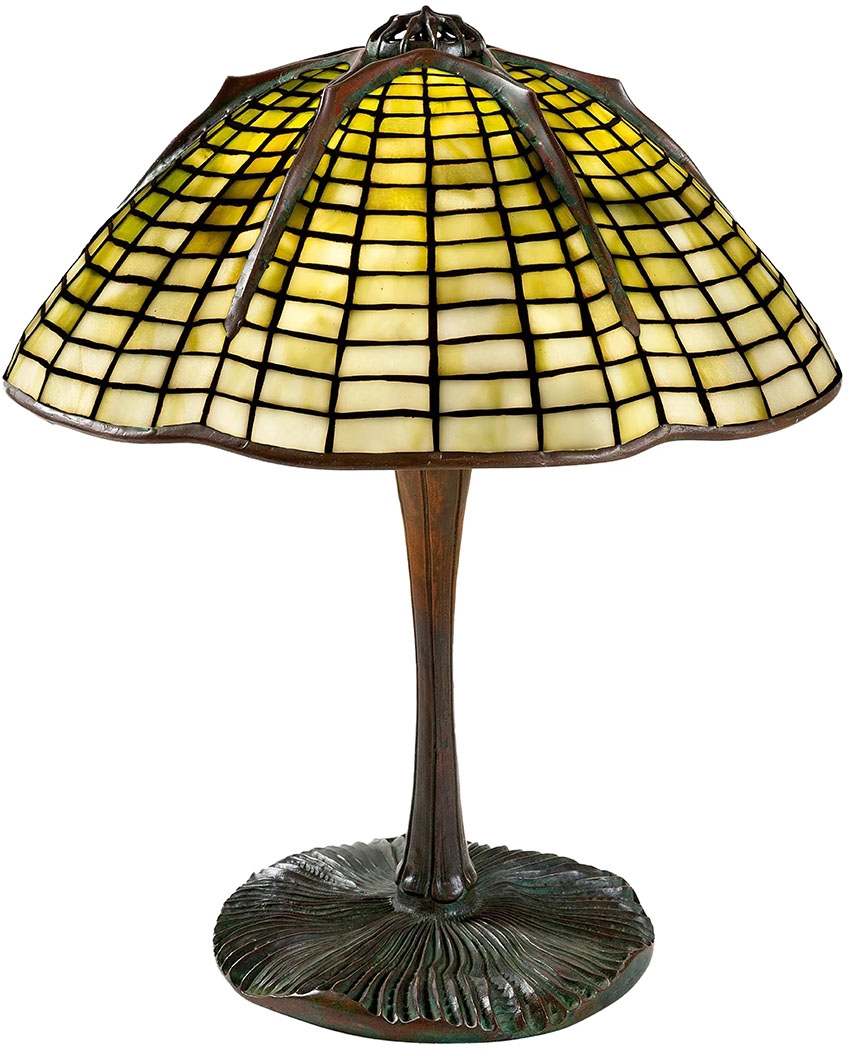
View from the top

“SEVEN LIGHT LILY” TABLE LAMP
Circa: 1901-1902. Dimensions: 11″ diameter x 21″ height
Materials: Favrile Glass, Bronze
Curators’ comments: “This Tiffany Studios New York glass and bronze Seven Light Lily table lamp, features seven golden iridescent Favrile glass Lily shades on individual bronze stems extending upwards from an intricately sculpted and detailed bronze Lily Pad base”. “This exquisite and unique Lily lamp marks the combination of two of Tiffany’s favorite floral motifs, the pond lily and the morning glory. These shades take the form of morning glories; entranced by their polychromatic brilliance and trumpet-like shape, and inspired by popularly distributed Japanese woodblock prints, Louis Comfort Tiffany made many water-color paintings of morning glories and meditated on them frequently”.
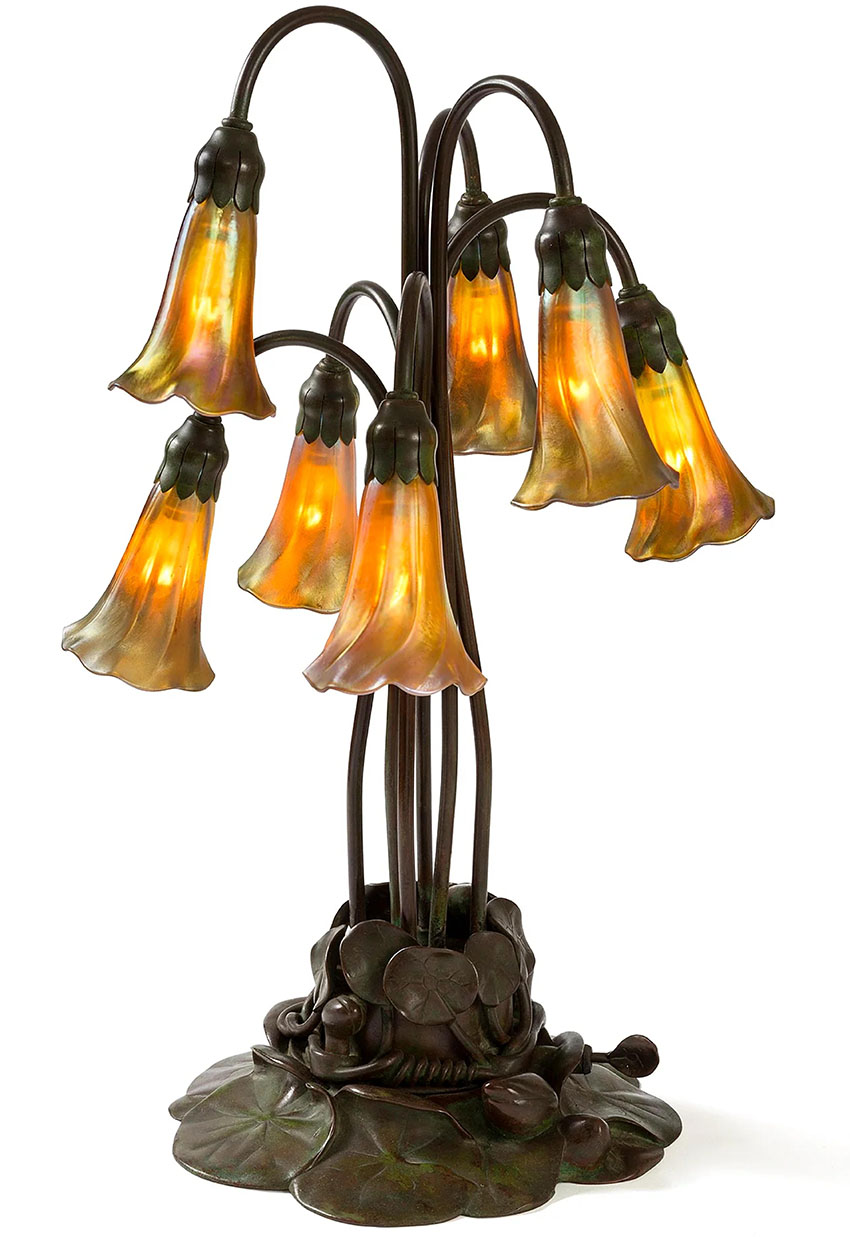
View of the space created by Ben Macklowe to display
the works in the exclusive Jade colour
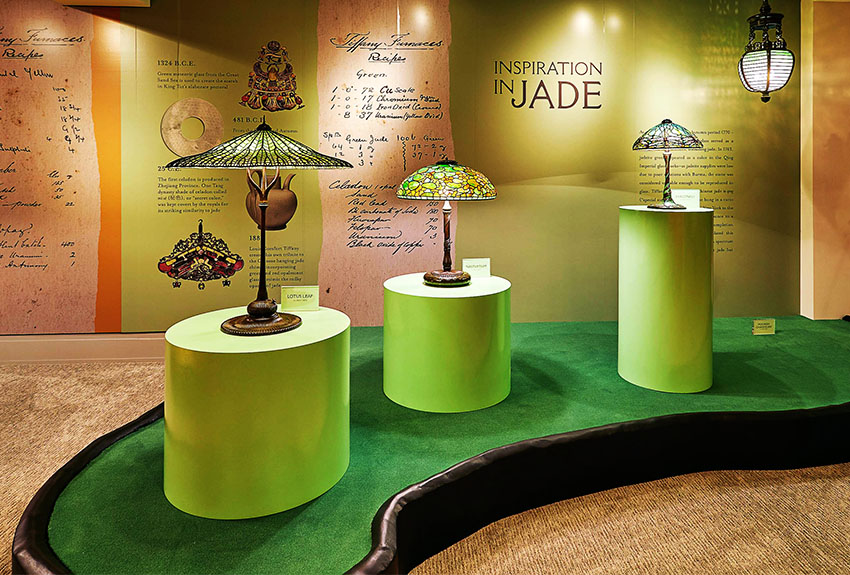
“JEWELED GEOMETRIC” TABLE LAMP
Circa: 1910. Dimensions: 22.5″ diameter, 30.25″ height
Materials: Leaded glass, Bronze
Curators’ comments: “This Tiffany Studios New York Jeweled Geometric leaded glass and bronze table lamp features an enticing shade, comprised primarily of gradient-hued green glass in a geometric arrangement”. “This lovely pattern is interrupted by thick band of bronze openwork in a vegetal pattern, beautifully adorned with iridescent glass beads of various colors, imitating the appearance of beautiful cabochon jewels”.
“The shade sits atop a patinated bronze telescoping Ball base. The finial cap is adorned by a glass bead”.
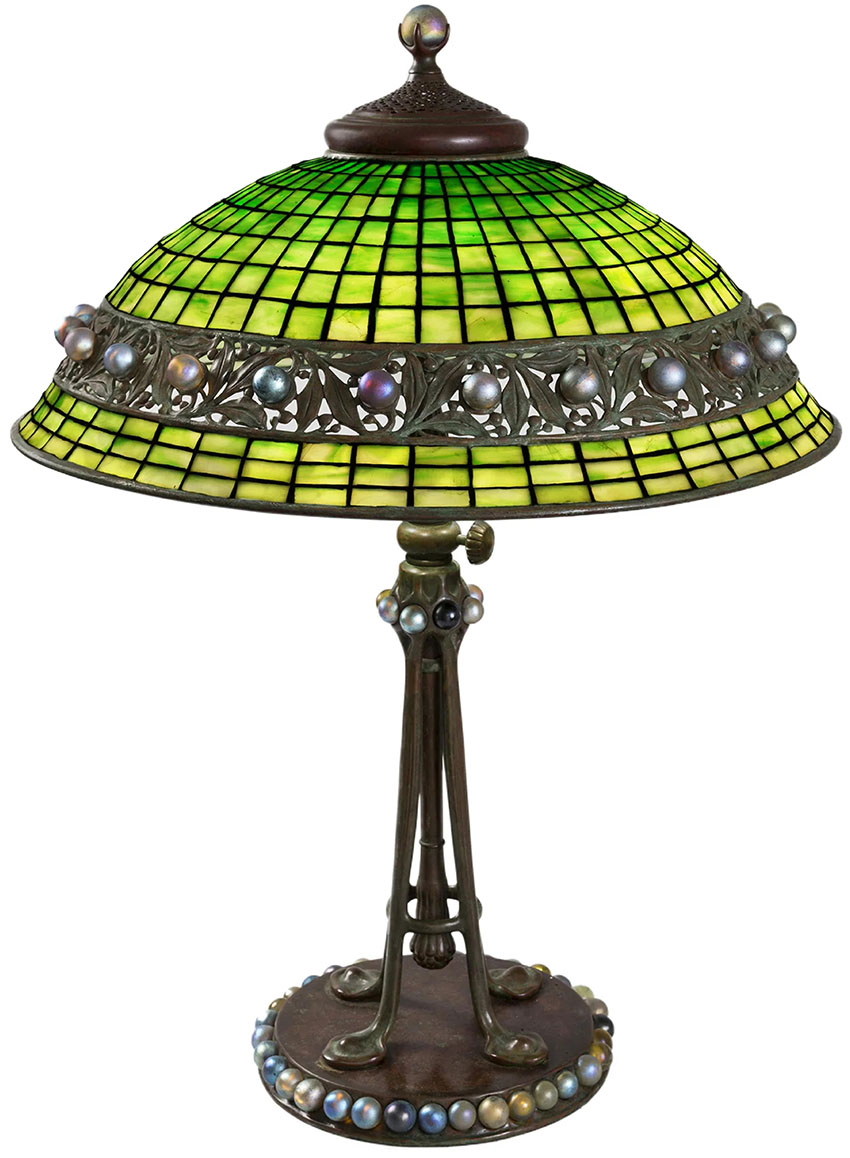
“MANDARIN” TABLE LAMP
Circa: 1900. Dimensions: 26.5″ diameter x 31.5″ height
Materials: Leaded glass, Bronze
Curators’ comments: “This Tiffany Studios New York Mandarin table lamp, considered among the most architecturally complex of the firm’s designs, features an ombre leaded glass shade that graduates subtly in hue from the most vibrant green to an almost milky white, and sits on a patinated bronze base specifically designed to accompany it”.
“The lamp is notable for its Eastern influence, as the shape of the shade designed to mimic that of a Japanese parasol as well as a lotus leaf, and for its early hybridization of the two tranches of Tiffany Studios New York designs; the geometric and the floral”.
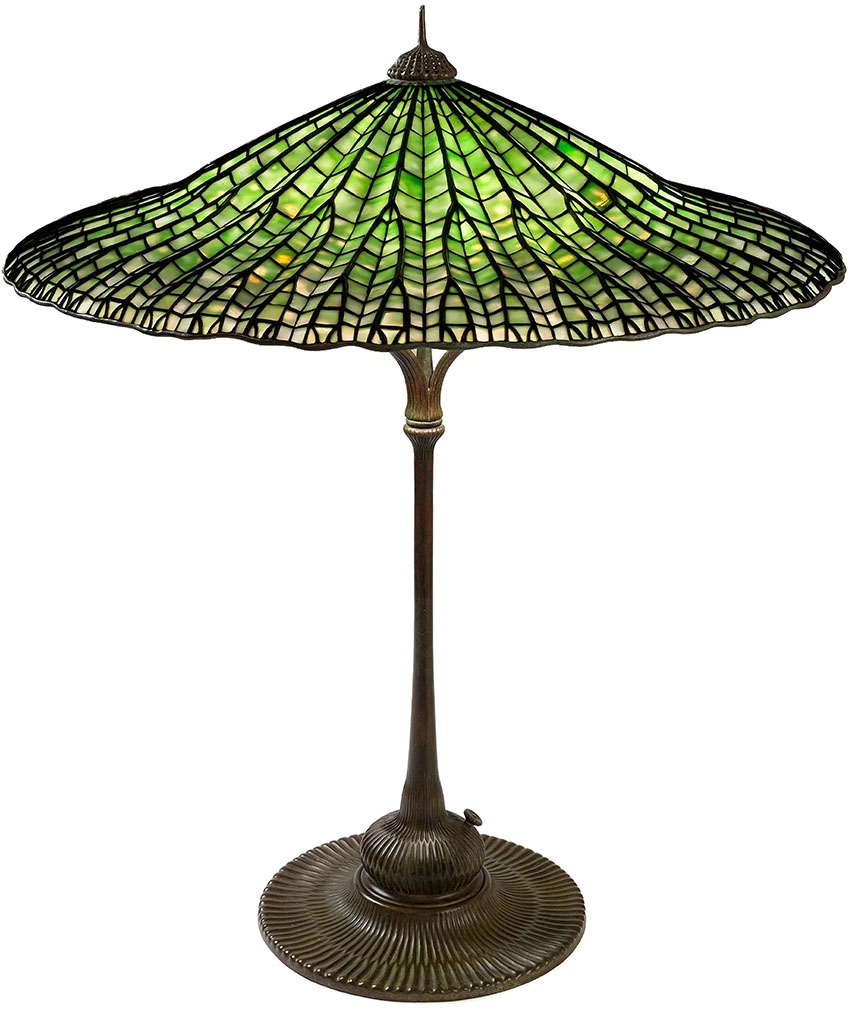
View from the top
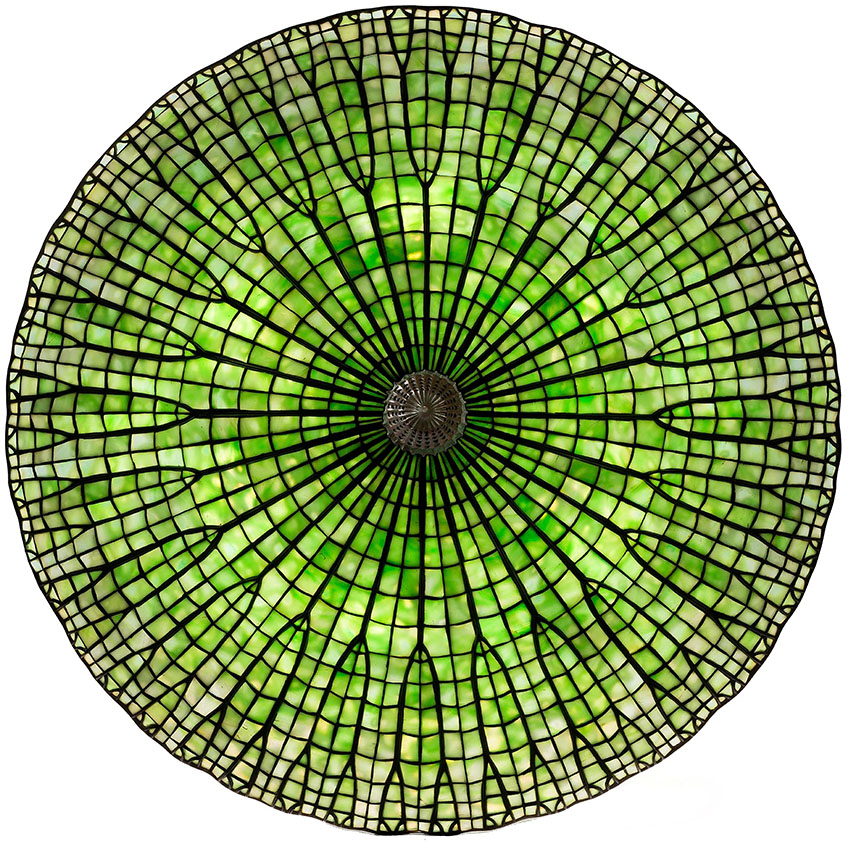
“SWIRLING LEMON LEAF” TABLE LAMP
Circa: 1900. Dimensions: 18″ diameter, 23.5″ height
Materials: Favrile glass, Bronze
Curators’ comments: “This Tiffany Studios New York Swirling Lemon Leaf table lamp, consists of a dynamic shade with Louis Comfort Tiffany’s famed geometric brick design in an ombre of chartreuse to white. Interrupted at its girdle by an intriguing band of vined leaf motifs in bright yellow-green. The swirling leaf patterning dynamically mimics the shape and implied movement of a pinwheel, paired with a patinated bronze ball fringe that provides more movement at the base of the shade, suggesting that the vegetation is about to spin about the lamp as it disperses beautiful light. The shade sits atop a four-footed adjustable, patinated bronze, Cat’s Paw base. Paw feet are some of the oldest motifs in furniture, appearing in Ancient Greek and Egyptian furniture”.

View from the top
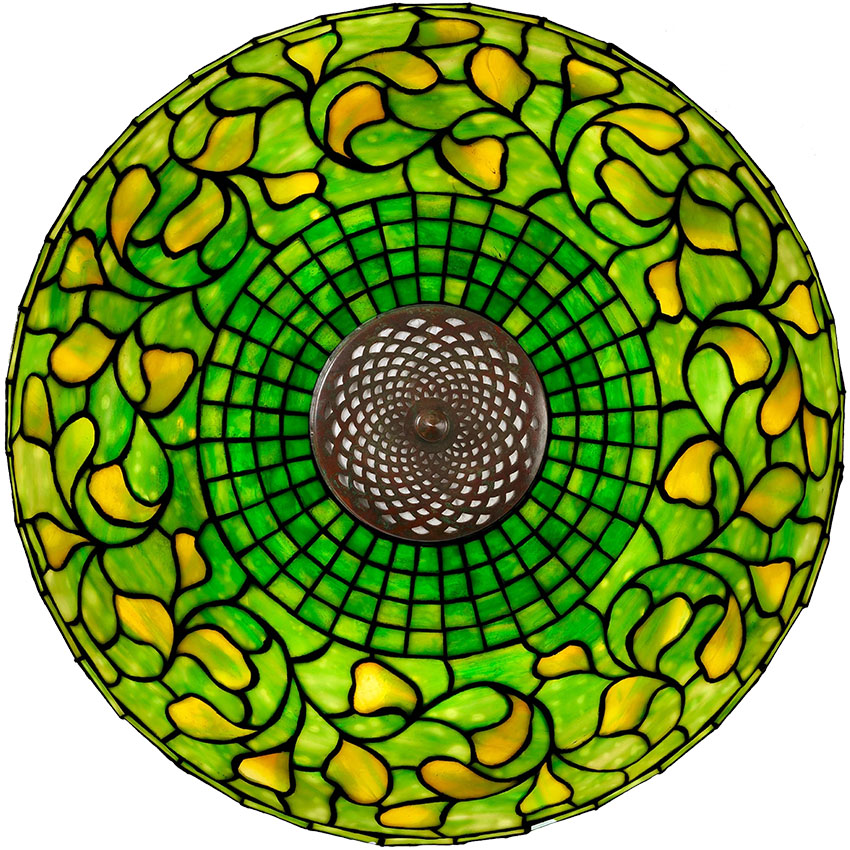
“GENTIAN” FLARED TABLE LAMP
Circa: 1900. Dimensions: 17.5″ diameter (shade), 23″ height (full lamp with base)
Materials: Leaded glass, Bronze
Curators’ comments: “This Tiffany Studios New York Gentian table lamp sports a special flared shade, comprised of an exciting and unique composition of floral Gentian flower stalks of leaded green, blue, and white glass, enclosed in the patterning of Gothic arches”.
“The middle row of the flaring apron is comprised of a row of uncut green glass meant to mimic the appearance of gemstones. The patinated bronze base complements the shade’s composition by featuring openwork flower stalk decoration with a darker, gothic feel”.
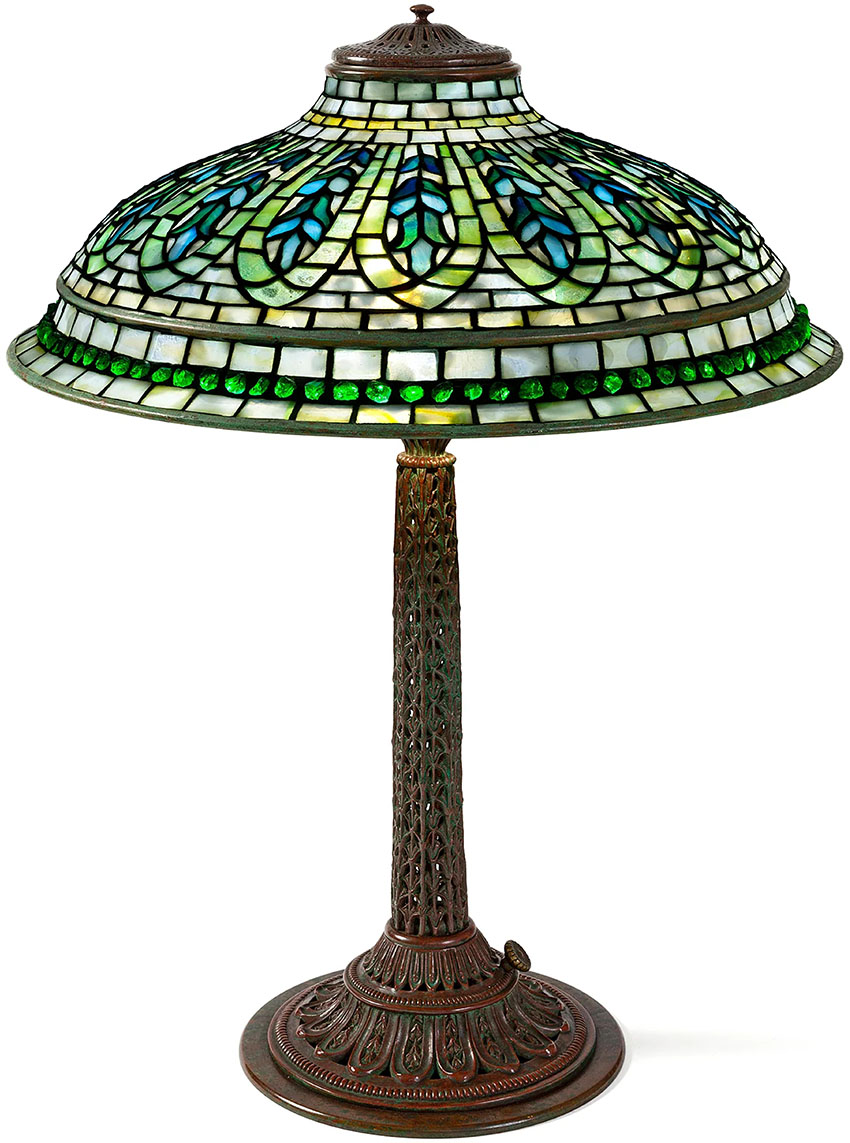
View from the top
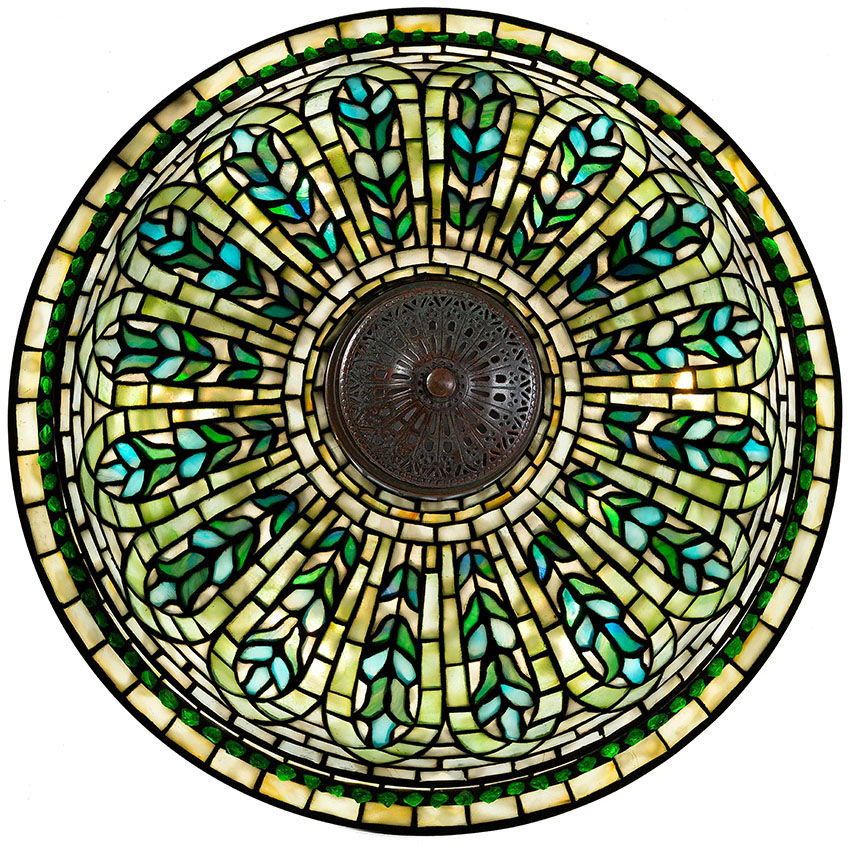
More detailed information on these Tiffany lamps can be found at https://www.macklowegallery.com/pages/tiffany-in-color
Interviewing Ben Macklowe
2nd generation owner and president of Macklowe Gallery
 PATRONS: You have been interviewed by the most important press in the world. What is the important question you would have liked to have been asked and no one has asked you?
PATRONS: You have been interviewed by the most important press in the world. What is the important question you would have liked to have been asked and no one has asked you?
BEN: “Why should people consider Art Nouveau and Tiffany Lamps as art forms on par with fine paintings?
P: What are the criteria for selecting a work to be in Macklowe Gallery?
BEN: Firstly and most importantly, that it is an object of beauty. Our collection spans many forms and eras but enduring beauty is the red thread that ties it all together. We also select museum-quality works for their artistic value, rarity, and historic importance. Our clients depend on us to present them with the “best in class” options for all our collecting categories, regardless of price. We also advocate for them by ensuring each piece is authentic and in excellent condition.
P: Globally, museums are in a time of great transformation. You have designed on your website one of the most precise curatorial processes that effectively contributes to education on a subject. Do you think this experience can serve as a reference for other museums in the process of renewing their museography?
BEN: We redesigned our website with the singular goal of bringing clients the education and inspiration they seek from us in the gallery, translated into a digital experience. And we’ve been thrilled to learn that it’s possible to breathe new life into objects of antiquity through extensive photos, videos, academic writing, and the opportunity to chat with a curator one-on-one, just as you would in real life. We’ve seen tremendous success with this approach, and believe it can absolutely benefit other institutions who aspire to expand their reach to new collectors and appreciators.
P: The works you present at the Macklowe Gallery are museum level. Have you thought about organizing Master Classes on Park Avenue for curators scholars and art history students?
BEN: What a fabulous idea! We do offer regular seminars and visits to the gallery through some of our partner institutions, and have also recently launched “Collecting at Home,” a video lecture series that I have great fun hosting. We endeavor to share our collection as broadly as possible with those who appreciate it, and Master Classes just may be the next brilliant step.
P: Many collectors love the idea of displaying their collection in public. Do you think you could organize traveling exhibitions in museums with the works that were acquired in Macklowe Gallery?
BEN: It’s absolutely on our wish list – we discussed “Tiffany in Color” traveling to a few cities, but the logistics of moving 20 antique glass lamps proved beyond our current bandwidth. Hopefully, eventually, we will! Collectors love their collections, but very few of them have the opportunity to share their passions with the general public, so I think organizing a “Masterworks Acquired at Macklowe Gallery” exhibition would be very exciting for them.
P: Are there any projects to publish books specialized in Art Nouveau?
BEN: You may be something of a clairvoyant! We have been long gestating a big idea for a book on Louis Comfort Tiffany. We were fortunate to publish “Dynamic Beauty” , a compendium of Art Nouveau sculpture, in 2011, and “Nature Transformed”, focusing on Art Nouveau horn jewelry, in 2013. We hope to build on this success in the coming years.
P: What have been the most exciting moments in the Gallery’s history?
BEN: Opening our first store in 1971, at the corner of 82nd and Madison – New York’s first true destination for Art Nouveau. Creating relationships with collectors like Barbra Streisand, Whoopi Goldberg, even a young Steve Jobs. Moving to 445 Park Avenue and expanding the collection. Launching “Tiffany in Color” in the spring of 2023. On a personal note, I feel incredibly lucky to have had intimate conversations about music with Paul Simon, Bruce Springsteen and Frank Ocean, who we are proud to count among our clients.
P: Lloyd and Barbara Macklowe prepared you to direct the Gallery. Is there another Macklowe preparing to continue the Saga?
BEN: I have two young sons (age 7 and 8) and if either of them choose to work in the family business, I’ll be honored! One thing we’ve learned in the past few years, particularly as we’ve evolved our digital presence, is that there really is an appetite for collecting among the younger generation. If we can convince a couple of them to take over the gallery, I would retire a happy man.
ABOUT LOUIS COMFORT TIFFANY
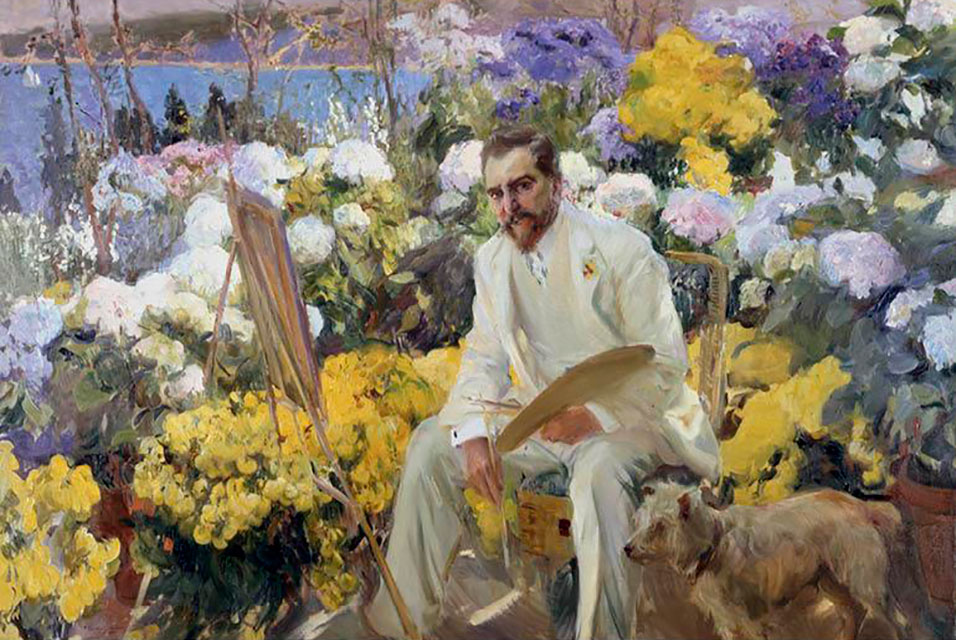 Louis Comfort Tiffany by Joaquín Sorolla, 1911
Louis Comfort Tiffany by Joaquín Sorolla, 1911
oil on canvas, 150.5 x 225.4 cm. Hispanic Society of America, New York
Tiffany Studios New York, established in 1880 by Louis Comfort Tiffany, was a decorative arts company best known for its glass windows, lamps, mosaic installations, and luxury items, such as desk sets, using multi-colored, textured, opalescent glass to create a unique type of stained glass.
By 1893, the Tiffany Glass Furnaces, as it was known as the time, created a blown glass, called Favrile glass, which is a signature construction for glass in a remarkable amount of designs. In 1895, Tiffany Studios New York began producing their renowned and highly collectible handmade stained-glass lamps, featuring the use of mosaics, often crafted in conjunction with designer, Clara Driscoll, who created each of the patterns for Tiffany lamps.
Geometric lamps reflect an Arts & Crafts style, while lamps adorned with peonies, poppies, and daffodils evoke an Art Nouveau aesthetic. Tiffany chandeliers grew out of a fascination with Asian influence and the culture of the Middle East. Tiffany Studios New York Dragonfly lamps are influenced both by Japonisme and Louis Comfort Tiffany’s close study of nature. Lily lamps, made with Tiffany’s golden iridescent Favrile glass, are a synthesis of naturalism and lighting as Modernist sculpture.
ABOUT MACKLOWE GALLERY AND ART NOUVEAU
The Macklowe Gallery’s extensive inventory of Tiffany Studios New York lamps includes Art Nouveau lamps from Louis Comfort Tiffany just before 1900 to the end of Tiffany Studios New York production in 1928. The gallery has the largest inventory of authentic antique Tiffany Studios New York lamps for sale in the world, and all Tiffany lamps, as well as the entire antique collection, are available for private viewing at the gallery’s Park Avenue location in Manhattan.